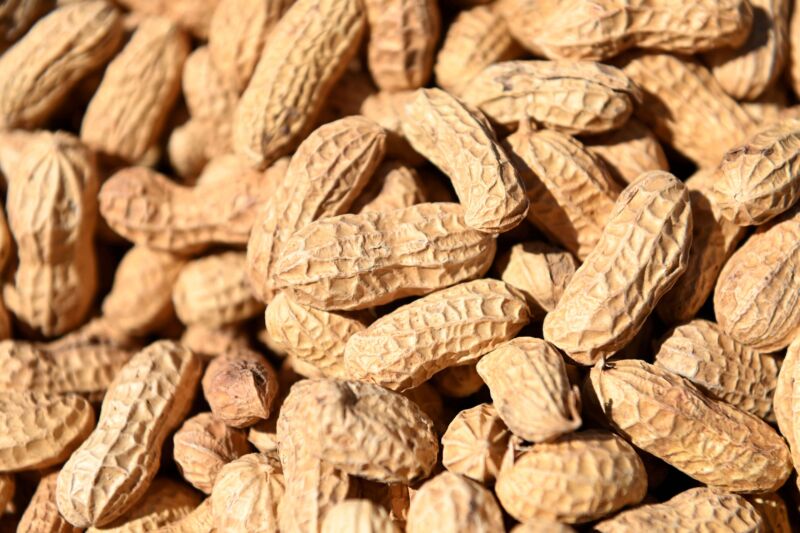Taking the edge off —
Injections over several months allowed people to tolerate larger doses of trigger foods.

Enlarge / Peanuts
Living with food allergies can be a fraught existence. There is no cure, and the standard management is to be ever vigilant of everything you eat and have an emergency shot of epinephrine constantly handy in case an accidental ingestion leads to a swift, life-threatening reaction. But, for the millions of people in the US who live with such allergies, a new drug may dull the threat.
On Friday, the Food and Drug Administration approved the antibody drug omalizumab (brand name Xolair) as an injection to lessen allergic reactions to foods in people ages 1 and up. In a trial of 168 children and adults with multiple food allergies, participants who received shots of omalizumab for 16 to 20 weeks were much more likely to tolerate a test dose of allergy-inducing foods at the end than those who received a placebo.
Omalizumab—which was previously approved to treat asthma, hives, and nasal polyps—works by binding to a class of antibodies in the body called immunoglobulin E (IgE) that are specifically involved in allergic responses. The monoclonal antibody drug binds IgE, blocking it from binding to its target receptor, thus preventing it from triggering the immune responses that lead to allergy symptoms.
“This newly approved use for Xolair will provide a treatment option to reduce the risk of harmful allergic reactions among certain patients with IgE-mediated food allergies,” Kelly Stone, associate director of the Division of Pulmonology, Allergy, and Critical Care in the FDA’s Center for Drug Evaluation and Research, said in today’s announcement. “While it will not eliminate food allergies or allow patients to consume food allergens freely, its repeated use will help reduce the health impact if accidental exposure occurs.”
The trial began in 2019 and was run by the National Institute of Allergy and Infectious Diseases and is still ongoing. But an interim analysis of early data was enough to convince the FDA of the drug’s benefit.
More tolerance
For the trial, researchers recruited people who had an allergy to peanuts, as well as at least two other food allergies, including milk, egg, wheat, cashew, hazelnut, or walnut. Those assigned to get omalizumab received shots every two to four weeks for 16 to 20 weeks. Afterward, researchers looked at whether participants could handle 600 milligrams or more of peanut protein, which is equivalent to eating about 2.5 or more peanuts. Of those who got the shot, 68 percent (75 of 110 subjects) handled the peanut doses without moderate to severe allergy symptoms, such as whole-body hives, persistent coughing, or vomiting. In the placebo group, only 6 percent (3 of 55 subjects) managed this.
As secondary tests, the researchers tried other allergy-triggering foods at the higher dose of 1,000 milligrams or more. For cashews, 42 percent (27 of 64) of participants who received omalizumab tolerated the challenge without moderate or severe allergic reactions, compared with 3 percent (1 of 30) in the placebo group. For milk, 66 percent (25 of 38 subjects) who received the drug tolerated the dairy, while only 11 percent (2 of 19) of the placebo group did so. For egg, 67 percent (31 of 46 subjects) on the drug tolerated the dose, compared to 0 percent of the 19 who received placebo.
The benefits of omalizumab were not universal. The FDA notes that 17 percent of the people who received the drug had no significant improvement in their sensitivity to allergy-triggering food. As such, the FDA cautions that even if people receive Xolair, they should still avoid the foods that trigger their allergies.
The trial is ongoing, and researchers plan to look at the longevity of the drug’s effectiveness and whether it can be paired with another strategy to ratchet down food allergies: oral immunotherapy (OIT), which uses small, daily doses of an allergen to build tolerance over time. For the look at longevity, some trial participants will get shots for an additional 24 weeks, followed by more food challenges to see if the drug remains useful at easing allergic responses over the prolonged time period. For the OIT part of the trial, participants will get another 16 weeks of injections and, halfway through that, some will undergo multi-allergen OIT. They will then be followed for 44 additional weeks.
The FDA says the most common side effects of omalizumab are injection site reactions and fever, but the agency also warns of the possibility of joint pain, rash, parasitic infections, malignancies, and abnormal laboratory tests.